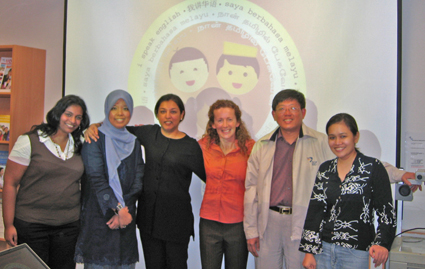In 2005, CRPP began the first massive study on the language use, proficiency and identity of Singaporean children. Three years down the road, SingTeach catches up with the research team to show you what they’ve found out.
Learning to speak more than one language is a large part of growing up in Singapore. Yet, little is known about how we decide to choose, use and develop the languages we speak. As the nation’s multiracial society continues to grow, there needs to be a clearer picture of exactly how we communicate.

The Sociolinguistic Survey of Singapore is an ambitious large-scale project by the Centre for Research in Pedagogy and Practice (CRPP) aimed at understanding the language use, ideology, proficiency and identity of 10-year-olds in Singapore. Now in its third year of implementation, the research team shares what they’ve found out with SingTeach.
Pertinent Findings
The team’s findings indicate that the way young Singaporeans use language is largely dependent on context, with constant code-switching depending on the speaker, the location, and even the type of conversation going on. Below is a brief look into some of their findings:
Who am I talking to?
- A majority of the children surveyed prefer to use English at home. Seventy-one percent use English, sometimes mixed with their mother tongue (Mandarin, Malay or Tamil), when speaking to their siblings. However, when speaking to their grandparents, 85% of them use the vernacular.
- Chinese children tend to use more English to discuss school work and other matters while Malay children tend to use their mother tongue when they are with friends of the same race. All three groups indicated that they are most comfortable with friends who can speak both English and their mother tongue.
How do I decide?
- The team noticed that the students code-switched often. “This literacy practice is often disallowed in Mother Tongue classes but in reality, people do code-switch when they communicate,” says Dr Viniti Vaish, one of the project’s principal investigators.
- Children’s perceptions of the person they are addressing influences what language they use. For example, in one activity, a child was given $10 to spend in a mall. Interestingly, she spoke to the shopkeeper in her mother tongue but spoke to the researcher in English because she felt that she needed to use English to speak to an “educated” person.
What do I like to watch?
- Chinese children watch a lot of Chinese programmes and movies whereas the Malay children do not like watching programmes in their mother tongue.
- Some Indian children only watch Tamil movies. Their parents do not allow them to watch English-language “made-in-Hollywood” programmes because they feel that the language used is unsuitable. Despite this, these children speak fluent English.
Am I good at using this language?
- When asked to rate their language abilities, the children rated themselves much higher than what the school rated them.
- The majority of them indicated high levels of proficiency in English. Of the three groups, Indians indicated the highest level of proficiency in English.
- Chinese children generally had a less than positive attitude towards their mother tongue.
Is it part of who I am?
- The children are comfortable using English to express their religious identities; they do not necessarily link race with language.
- When a child was asked if speaking in Malay made him feel Malay, he replied: “I got the colour of Malay so I feel like Malay.” He added that even if he spoke English, that would not make him feel less Malay.
Practical Applications
“Each language that is in the mind and heart and soul of the child helps in the understanding and comprehension of the other languages,” says Dr Vaish. “We need to find ways to accommodate these biliteral practices as an English-only or mother-tongue-only space can be quite constraining for the child.”
For example, if a child cannot pronounce an English word but if he or she can write it in a different script then he or she would have understood and learned the word in his or her own way.
Dr Vaish feels that movies and music are great resources for teaching since most children watch a lot of movies and listen to music in their mother tongue. However, the current national school curriculum does not allow for popular culture to be incorporated into classroom pedagogy.
“This could be due to cultural reasons and the feeling that the text you encounter outside the classroom looks so different from traditional literacy texts. The child might feel that entertainment outside school are the fun things and are unrelated to school,” explains Dr Vaish. “We should try to bridge this gap, and sensitively incorporate popular culture into the classroom.”
The research team hopes that their findings can help teachers understand more about how their students feel about their own language and how they rate their language abilities. Teachers can use this information to address language areas that the children are weak in.
What was this project about?
There were two stages in the Sociolinguistic Survey. The first stage was the quantitative survey, which was administered face-to-face in the students’ homes. A total of 668 Chinese, Malay and Indian students took part in this survey.
The second stage involved qualitative follow-up studies, which aimed to develop a clearer picture of the patterns of language use, ideology and proficiency of the students. Twelve students were involved in this part of the study.
The researchers planned an activity for the students each time they visited, such as visits to shopping malls and religious places. All these interactions were audio- and video-taped. As part of the qualitative study, the children were also given tape recorders and encouraged to record their exchanges with others as well as to keep a journal and log of their experiences, feelings and activities.
> To read an earlier article on this project, click here.
> To read more about the project, click here.
